As a Disney nerd with a love of horror, I don’t think I’ve ever been more excited for a video game than I was after concept art for the original Epic Mickey leaked back in 2009. This was nightmarish stuff; all shambling animatronic monstrosities and apocalyptic landscapes haphazardly reassembled from the rotting remnants of Disney’s beloved theme parks. We saw Epcot’s shattered Spaceship Earth roaming a vast, rust-coloured ocean atop something part Rivers of America steamboat, part monstrous narwhal; Snow White’s castle balanced high on an impossible precipice amid belching, churning industrial machines; even a razor-limbed robotic caterpillar with Abe Lincoln’s animatronic head jammed awkwardly on one elongated neck while the shocked face of Mickey Mouse wobbled horribly on another nearby.
It was a tantalising vision of an Epic Mickey that, perhaps inevitably, never came to pass. But there was still something of that initial darkness – albeit dialled back to more family friendly levels – when Epic Mickey eventually landed on Wii the following year. Yet even in its considerably more approachable form, it was a fascinating curio: a far wilder, weirder, and more ambitious effort than any licensed video game ever realistically needed to be, and an obvious labour of love for designer Warren Spector and his team at Junction Point Studios. As a heartfelt ode to nearly 100 years of often forgotten Disney creativity, it was a delight, but as a video game it was rather less so – a little too much of its magic lost amid its awkward platforming and a deeply frustrating camera. But 14 years later, all that’s been fixed in developer Purple Lamp’s savvy Epic Mickey: Rebrushed remaster, and the result is something of a revelation; a rare opportunity to revisit a flawed relic, its incredible artistry finally able to properly shine.
And that, of course, starts with the wonderfully conceived Wasteland, a dark reflection of Disney’s iconic theme parks where Mickey Mouse’s adventure unfolds. It’s a world strewn with discarded Disney ephemera and home to long-forgotten cartoon characters, from Clarabelle Cow to Oswald the Lucky Rabbit (who ironically now enjoys a renewed presence in Disney Parks, thanks to his Epic Mickey revival). It’s also a world where a melting Cinderella’s castle teeters menacingly on the horizon as the mouldering Americana of Mean Street looms either side; where dead-eyed mechanical Dumbos whirl jerkily against the crumbling façade of Disneyland’s It’s a Small World ride, and where the Toontown-inspired suburb of OzTown squats in the shadow of Mickeyjunk Mountain – a colossal scrapheap of Mickey Mouse memorabilia: Pez dispensers piled upon posters stacked against giant push-button telephones. It’s glorious stuff; a wild, celebratory melding of iconic Disney artistry and the deepest of cuts from the company’s past, all squished into a cohesive, remarkably coherent whole.
Over in Tomorrow City, for instance, Junction Point conjures the spirit of Disneyland’s long-defunct Skyway and People Mover rides to craft a spaghetti-like retro-futuristic playground before firing players up to the top of Space Mountain for a boss fight riffing on Tron. Ventureland, meanwhile, is part Jungle Cruise, part Pirates of the Caribbean, smushed comfortably against the world of Peter Pan – and then there’s Lonesome Manor, a glorious amalgamation of Disney’s spookier side, at which point the Haunted Mansion obsessive in me starts to swoon. But that’s just the 3D platforming stuff; some of Epic Mickey’s most striking moments come as it delves into the world of Disney’s beloved animated shorts, turning classic capers like Steamboat Willie, Thru the Mirror, Mickey and the Beanstalk, and Plutopia into brisk bouts of side-scrolling action. And all of it is given a beautiful, respectful makeover in Epic Mickey: Rebrushed – one that comes perhaps a little closer to capturing the wonderfully ghoulish spirit of that early concept art, without ever losing the original’s welcoming, whimsical charm.
It’s not that Epic Mickey’s world wasn’t already a highlight back in 2010, but Rebrushed certainly makes it easier to appreciate when you’re not constantly fighting a wayward camera and slightly turgid controls. And that goes for the rest of the experience too. Beyond its striking visual upgrade and traversal finessing, Rebrushed isn’t a radical upgrade, but it’s a considered one, and its clever tweaks help bring some of the original’s other strengths to the fore.
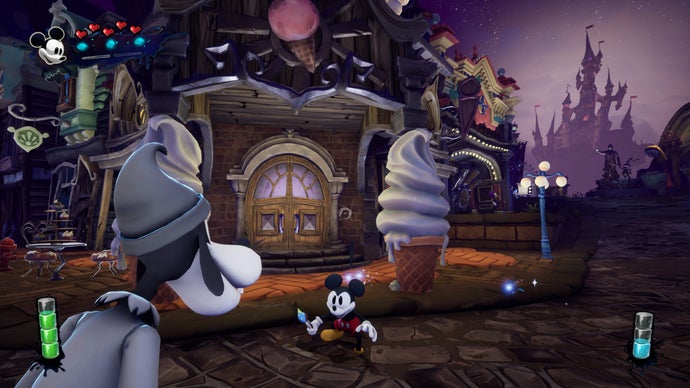
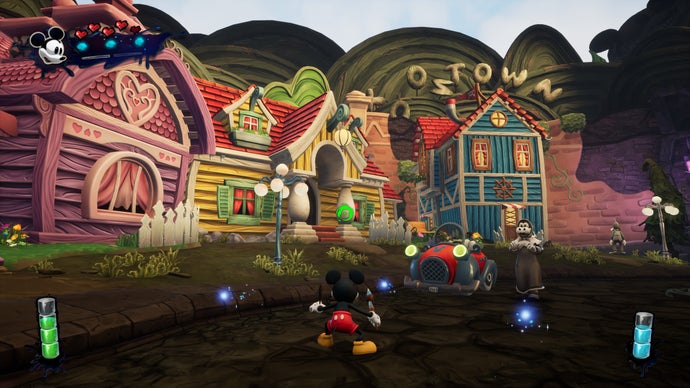
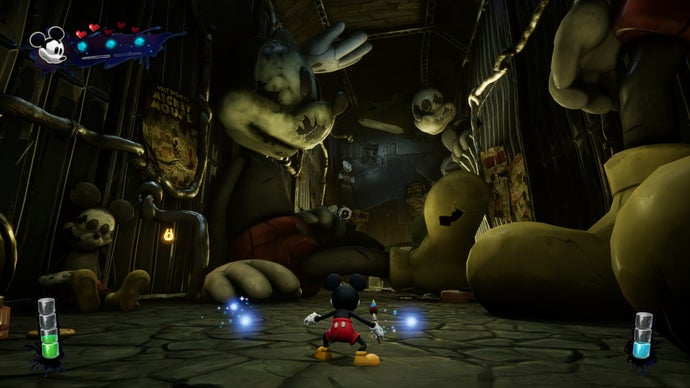
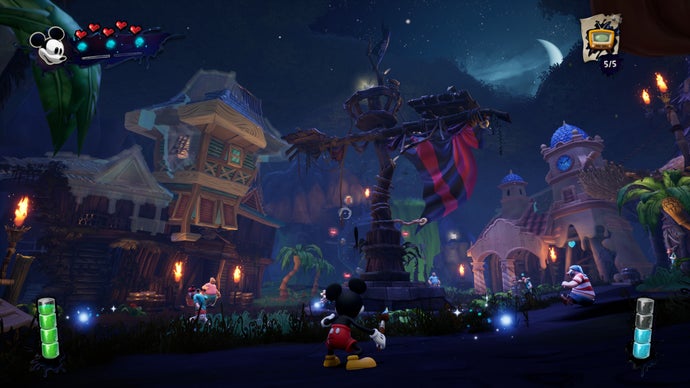
Its level design, for instance, is pretty fantastic when you’re not grappling with the fundamentals. Once away from the hub-like Mean Street, you’re whisked through a succession of self-contained mini-levels, from storm-ravaged tropical coves to spooky hilltop mansions, each presenting players with a progress-critical core objective – open that gate, perhaps, or raise this platform – and usually an optional quest or two. It’s all relatively simple, kid-friendly stuff – a bit of ‘go here’, ‘yank this’, ‘move this over there’ – but it’s a non-linear approach that lends a compelling exploratory edge to the traversal platforming and gentle puzzling.
But Epic Mickey goes even further. Virtually every objective can be completed multiple ways, with decisions having genuine (if rarely especially dramatic) consequences. When faced with a choice between disabling a location’s deadly electrical current or halting its procession of aggravating tram cars, for instance, the decision feels weightier knowing either might close off a specific path and prevent you from reaching a handful of collectibles on this particular playthrough. And then there’s Epic Mickey’s morality system, which – despite being probably the last thing you’d expect to find in a family focused licensed cartoon game – somehow works, cleverly folded into the rest of the action by Epic Mickey’s core gimmick: a magical paintbrush capable of either filling in or erasing specific parts of the world, depending on a player’s whims.
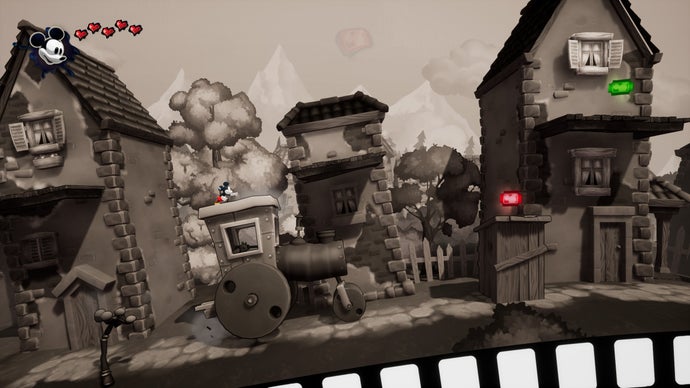
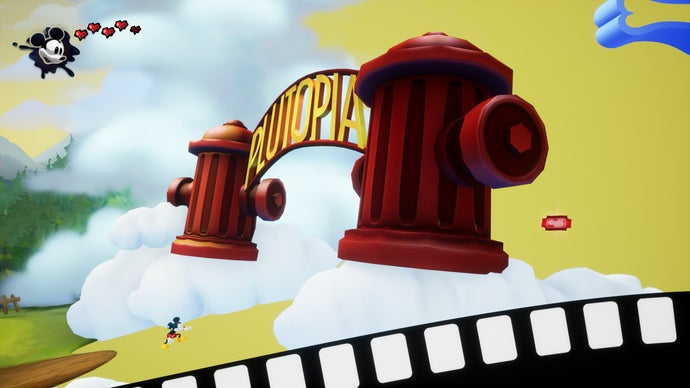
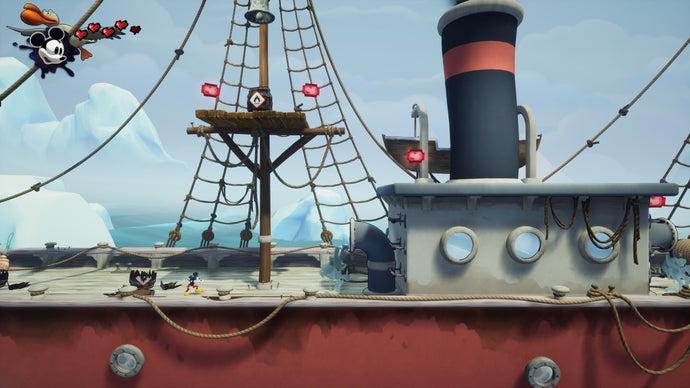
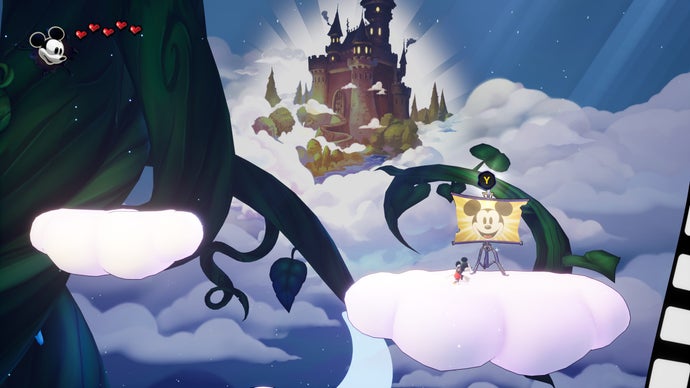
It’s a mechanic underpinning exploration, platforming, puzzling, and even combat, and one that Junction Point exploits in often satisfyingly clever ways. But it feeds into Epic Mickey’s morality system in as far as the use of destructive thinner is generally considered ‘bad’, while paint is broadly thought of as ‘good’. Truthfully, the way the morality system tallies your actions and manifests the results is fairly inscrutable, and all it really amounts to are some slightly different reactions from the Wasteland’s denizens as your adventure proceeds, and one of two possible endings. But it does at least add a bit more texture to the whole thing; knowing there are ramifications for your actions, and multiple approaches to any given task, encourages a more curious, exploratory mindset – and there’s real pleasure to be found teasing out each area’s numerous pathways and secrets. That all this is radically enlivened by some genuinely satisfying traversal in Rebrushed, as you bound and splosh around with a fluidity and rhythm the original never quite managed to muster, just makes the whole thing even better.
In its original guise Epic Mickey was a bit of a disappointment, its clever design, admirable ambition, and a bold approach to its source material undone by just a little too much mechanical awkwardness. But Purple Lamp’s shrewd remaster really is transformative. Could Epic Mickey: Rebrushed have taken things a little further? Added voice acting? Pepped up its humdrum fetch quests? Sure, but even without more radical revisions, what’s here is a delight. It’s still perhaps a little too woolly, too unfocused to be truly considered a classic, but, some 14 years on, it’s wonderful to see the magic in Junction Point’s wild, weird original finally shine through.
